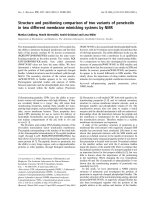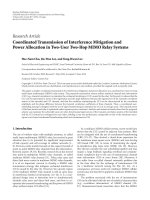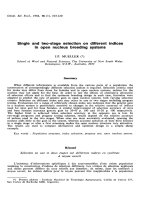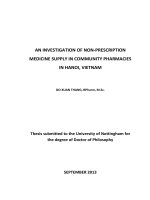Emergency supply in two echelon inventory systems
Bạn đang xem bản rút gọn của tài liệu. Xem và tải ngay bản đầy đủ của tài liệu tại đây (2.7 MB, 80 trang )
EMERGENCY SUPPLY IN TWO-ECHELON
INVENTORY SYSTEMS
KUAI JIAN
(BSc. University of Science & Technology of China)
A THESIS SUBMITTED
FOR THE DEGREE OF MASTER OF SCIENCE (MANAGEMENT)
DEPARTMENT OF DECISION SCIENCES
NATIONAL UNIVERSITY OF SINGAPORE
2004
ACKNOWLEDGEMENTS
A journey is easier if you can get helps. Interdependence is certainly more
valuable than independence. This thesis is the result of two years of work whereby I
have been accompanied and supported by many people. It is a pleasant journey that I
have now the opportunity to express my gratitude to all of them.
First of all, I would like to extend my wholehearted thanks to my supervisors
Asst Prof Mabel Chou and Assoc Prof Mark Goh. You are great supervisors, helping
me to select the topic of my thesis and directing me the right research directions. You
create ladders of hope and mobility which a research toddler like me can ascend,
rising as far as abilities permit. I will always remember the happy time we worked and
enjoyed together.
Many people have helped me out when I came across difficulties during the
development of this thesis. I would like to give special thanks to the members of my
proposal committee: Prof Wong Kie Ann, Assoc Prof Chou Fee Seng and Asst Prof
Ye Hengqing. Thanks for providing constructive comments during my thesis time as
well as on the preliminary version of it. Also, I thank Assoc Prof Brah A Shaukat,
Assoc Prof H. Brian Hwarng, Assoc Prof Ou Jihong, Assoc Prof Teo Chung Piaw,
Assoc Prof Thompson Teo, Asst Prof Hean-Tat Keh and Dr Chng Chee Kiong, with
whom I had many pleasant discussions on my study and life during the past two years
in NUS. I also would like to express my special thanks to Asst Prof Ye Hengqing,
who in the class of Operations Modeling & Applications trained my patience of
research, which is crucial for the computational study part of my thesis.
Also, I had pleasure to study and work with all my peer friends: Guo Feng,
Liu Xin Xin, Chen Wenqing, Men Bing, Xie Na, Zheng Hua, Zhang Miao, Lin
I
Yuquan and many other friends. With you, my confidence has been re-born.
This research has been supported and funded by National University of
Singapore. Thanks for providing all the facilities and financial support that enable me
to complete this thesis.
Finally, all my gratitude goes to my parents and brother. Your affectionate
encouragement has been constantly guiding me ahead to the final pilgrimage, be there
ever so many adversities, or ever so many unprecedented failures, or ever so strong
impulse to be necessary to my withdraw. Without you, I would be nothing.
II
TABLE OF CONTENT
ACKNOWLEDGEMENTS ............................................................................... I
SUMMARY ................................................................................................ IV
LIST OF TABLES ......................................................................................... V
LIST OF FIGURES ..................................................................................... VI
CHAPTER 1 INTRODUCTION .......................................................................1
CHAPTER 2 LITERATURE REVIEW .............................................................5
CHAPTER 3 MODELS AND MAIN RESULTS .................................................8
3.1 NOTATIONS AND ASSUMPTIONS........................................................................ 8
3.2 ONE RETAILER CASE ...................................................................................... 11
3.3 MULTIPLE RETAILER CASE WITH INCOMPLETE DEMAND INFORMATION
............................................................................................................................... 18
3.4 MULTIPLE RETAILER CASE WITH COMPLETE DEMAND INFORMATION
............................................................................................................................... 37
CHAPTER 4 COMPUTATIONAL RESULTS ..................................................45
CHAPTER 5 CONCLUSIONS .......................................................................53
BILIOGRAPHY ...........................................................................................55
CHAPTER 6 APPENDIX ..............................................................................58
6.1 CONVERGENCE THEOREMS ............................................................................ 58
6.2 PRELIMINARY COMPUTATIONS ...................................................................... 62
6.3 COMPUTATIONS OF DERIVATIVES .................................................................. 67
III
SUMMARY
We consider a single-period two-echelon inventory system which consists of a
single warehouse and single or multiple retailers. Each retailer faces a general
stochastic demand and an emergency supply option from the warehouse. The
objective is to find the optimal ordering policy from an external supplier so that the
system cost is minimised.
We derive the optimal ordering policy for the special case when there is only
one retailer. This is a two-variable convex problem and the optimal solution can be
got by considering different scenarios of parameter settings.
We also consider two settings for the case when there are multiple retailers. In
the first setting incomplete demand information is assumed while in the second setting
complete demand information is assumed for the emergency supply decisions. Under
the first setting, we show that the cost function is convex with respect to the initial
inventory levels of all locations and then find an iterative method to obtain the
optimal solution. Under the second setting, we show the convexity of the cost
function and use an iterative method to find the optimal solution of small scale
problems.
Vast computations with different parameter settings show the benefits of the
emergency supply and complete demand information.
At last, in the Appendix we derive some useful computational lemmas,
followed by their applications of calculating partial derivatives of the system cost
function.
IV
LIST OF TABLES
TABLE 3.1: OPTIMAL POLICIES WITH DIFFERENT WAREHOUSE’S CAPACITIES ...... 36
TABLE 3.2: STEPS OF GETTING THE OPTIMAL POINT ............................................... 44
TABLE 4.1: PARAMETER SETTING FOR RETAILERS ................................................... 45
TABLE 4.2: SYSTEM COSTS FOR DIFFERENT INVENTORY COSTS OF THE
WAREHOUSE............................................................................................ 46
TABLE 4.3: SYSTEM COSTS FOR DIFFERENT OVERAGE COSTS OF THE WAREHOUSE
................................................................................................................. 47
TABLE 4.4: SYSTEM COSTS FOR DIFFERENT EMERGENCY SUPPLY COSTS OF
RETAILER 2 ............................................................................................. 48
TABLE 4.5: SYSTEM COSTS FOR DIFFERENT EMERGENCY SUPPLY COSTS
(COMPLETE INFORMATION) ................................................................... 49
TABLE 4.6: SYSTEM COSTS SAVING % FOR DIFFERENT EMERGENCY SUPPLY COSTS
(COMPLETE INFORMATION) ................................................................... 49
TABLE 4.7: SYSTEM COSTS FOR DIFFERENT EMERGENCY SUPPLY COSTS
(INCOMPLETE INFORMATION) ................................................................ 50
TABLE 4.8: COST SAVING % FOR DIFFERENT EMERGENCY SUPPLY COSTS
(COMPLETE INFORMATION) ................................................................... 50
TABLE 4.9: SYSTEM COSTS FOR DIFFERENT SHORTAGE SUPPLY COSTS OF
RETAILER 1 ............................................................................................. 51
V
LIST OF FIGURES
FIGURE 3.1: GRAPHICS OF THE COST FUNCTION IN DIFFERENT PLANS……… ..13
FIGURE 3.2: RELATIONSHIPS OF THEOREMS IN SECTION 3.3……………………19
FIGURE 4.1: SYSTEM COSTS FOR DIFFERENT INVENTORY COSTS OF THE
WAREHOUSE…………………………………………………...……46
FIGURE 4.2: SYSTEM COSTS FOR DIFFERENT SHORTAGE SUPPLY COSTS OF
RETAILER 1………………………………………………….....……52
VI









